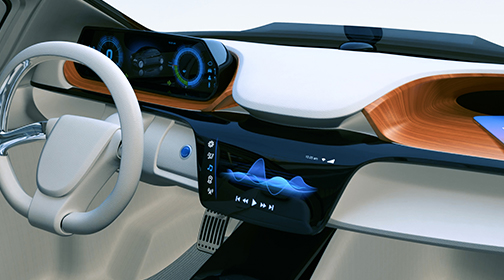Consumers are expecting radically different vehicles to show up on the road to get them from point A to point B. Future-forward innovators need to be aware of what is expected and provide consumers with an end product that will meet demands and even exceed expectations.
In this third Transportation and Mobility (T&M)-focused podcast episode, SIMULIA’s T&M Experience Senior Technical Manager, Adrien Mann speaks to the very different – and sometimes unexpected – challenges that designers are facing when developing Electric, Connected and Autonomous vehicles.
Cabin layout is going to be really a reinvention…everybody’s sitting in the same direction facing the road. But now you might have people turning around, facing each other. Future designs will have to be adaptable to those configurations and that’s going to be really challenging. – Adrien Mann
Enjoy the podcast with Adrien Mann.
3D Design and Engineering
Electric, Connected & Autonomous Vehicles
Be sure to listen into the other podcasts in this series and to learn more, please visit: https://go.3ds.com/ecav
Subscribe and listen to the podcast series on the following channels:
Podcast Transcript

Matthew Hall 0:10 Hi, welcome to the Dassault Systèmes podcast, “3D Design and Engineering.” In this series here on our podcast, we will be focusing on some of the latest trends, challenges and solutions that are going on right now in the Transportation and Mobility industry that are impacting Electric, Connected and Autonomous vehicles. I’m your host, Matthew Hall and joining us today I have with me my colleague, Adrien Mann on the phone with me. He’s our Senior Technical Manager with the SIMULIA brand for Transportation and Mobility Experience. Our guest started his career in aero-acoustics across multiple industries, and has expanded his expertise over many years into thermal management for vehicle cabin systems. Welcome, Adrien.
Adrien Mann 0:53 Thank you, Matthew. It’s a pleasure to be here.
Matthew Hall 0:55 Great. So let’s dive right in and get started with the questions. Wit the future expected to see a far greater percentage of the market shifting to Electric Vehicles – or EV’s – from a high-level and your perspective, what do you see as the primary challenge to today’s engineers when it comes to designing these EV’s?

Adrien Mann 1:15 Yeah, so excellent question. So you know, actually, what’s going to really change Electric Vehicles is our perception of vehicle. And that’s, that’s not just, you know, the electric part and then the autonomous part. All of this together is going to be a complete shift in paradigm from the transportation industry. When we look at the cabin itself, some of those specific challenges that designers are going to have to face are going to be around – while the first one is going to be the “Range Anxiety,” because when you when you shift from an internal combustion engine, where you will feeling comfortable, like immediately unlimited access to gas station, which is not entirely true, neither, but feeling that you you have to find somewhere to charge and charging, taking a lot of time, compared to just filling the tank, a lot of people are going to be concerned about the specific challenges of the Range Anxiety, and the cabin can play a role on that.
The second thing is, when you are in an Electric Vehicle, you know, just just in terms of the acoustics, I mean, just in terms of the noise that you hear, when you’re inside the cabin, it’s not the same at all, you don’t have the background noise of the engine, you know, covering all the other sources of noise. And so when the car is very silent, because you stop, and there is no noise at all, some of the other noise that we’re not necessarily paying attention to becomes very important. So that’s going to be a new type of acoustic design challenges for designers. And just what one last one, you know, when we think about the autonomous cars, I mean, we’re not going to be driving anymore. So we’re not even going be – the cabin layout is going to be really a reinvention of the cabin, in terms of the way we’re sitting the way we’re interacting with the cabin and that makes it even more challenging, because some of the systems we have in the vehicle, were adapted to, you know, everybody’s sitting in the same direction facing the road the world basically. But now you might have people turning around, they’re going to be facing each other. All these things means that your design has to be adaptable to those configurations and that’s going to be really challenging.
Matthew Hall 3:34 And there’ll be a whole new world for interior cabin design.
Fascinating. So let’s let’s talk about the my next question, which is about the environment, EV designers hope to market and sell future EV’s in a variety of locales geo’s around the world, most often with each of these areas having significantly different weather or environmental factors. How or what are designers doing to take on the challenge in design of EV’s of the future to provide the thermal comfort in varying hot and cold conditions, while at the same time keeping an acceptable battery range?
Adrien Mann 4:09 Basically, when you ever like an electric vehicle, something that people don’t necessarily know, but about 50% of the energies that are being drained from batteries coming from the cabin. Because when you when you have a traditional electric vehicle, sorry, a traditional vehicle, you basically take the energy from the powertrain to provide heat, I mean, the heat is just coming from the internal combustion engine. And an issue of air conditioning, the actual engine is going to be running the compressor that’s providing the cold air. But when you have an electric vehicle, it’s not the same thing. Because first of all, you’re not going to get the heat output from the engine; it’s actually not going to come from just electricity, like a radiator that’s equivalent of a radiator in the EV system to provide the heat in the cabin in the very cold weather. That’s really draining a lot of energy from the battery, which is a source of power. And then the same thing happens in very hot weather, you’re going to have the energy being pulled from the battery to run the car to run the compressor and provide the cold air. So those are really two key things that are very difficult to manage in terms of Range Anxiety, because you end up having this 40 to 50% drop in battery range just from using the cabin comfort. I don’t know if you’ve ever experienced this. But when you run an electric vehicle and you’re approaching to the end of the of the range, it’s actually proposing you to turn off the cabin comfort so that you can actually save battery to reach, your destination where you can recharge. It is definitely a big problem. Yeah,
Matthew Hall 6:04 Yeah, the inside of the car could be become quite uncomfortable very quickly if you’re out some place in like the Southwest. So I never I never even realized that the 50% is coming from the drain is coming from the inside. Wow!
Well, speaking of the battery and battery life – as we as we all know, a product is only as good as its battery. How do you see future EVs’ artificial intelligence evolving in order to play a bigger role in balancing the needs of interior cockpit comfort that you were talking about with the overall operation of vehicle which is very important, obviously?
Adrien Mann 6:37 Yeah, so artificial intelligence is going to be helping at optimizing the way the climate system is going to be providing the comfort in the cabin. So let me really go into more detail about the way that the targets are reset right now, by audience to provide comfort. It’s really just about making sure that the going to achieve a certain temperature in a certain amount of time, and that’s, that’s basically the target. And when you’re doing that, most of the time, you’re actually over-designing the system, and you’re going to be putting more energy from the system that you actually need to provide comfort. So it’s just that, you know, paying attention more to what’s going to be actually a measure of comfort of people from measuring, for example, the temperature of the skin of people, and then through simulation, you can get you know, the connection between the actual output of the EV system and the comfort of people. And, in use this to a training set, you know, in multiple conditions, multiple environments, multiple temperatures, multiple speed of the car, getting all this training set from the simulation, and you can use this data set to train a machine learning algorithm that is going to be making the decision about what should be the exact system inputs to provide a comfort given the environment inputs. That’s something that’s very challenging today, because you need the full prototype of the car to do this, and you don’t necessarily have the time to measure and we don’t actually have access to all the information about the flow, the temperature in the cabin, that simulation can provide to be able to make a decision, that is going to work down the road in terms of comfort. That’s really combination of simulation, and artificial intelligence that can bring what I would call an energy efficient comfort in the academy.
Matthew Hall 8:43 So with reliable simulation sounds like it can be done much faster, far more efficiently?
Adrien Mann 8:49 Exactly. I mean, you can in simulation, and you can reproduce the real world, if it’s reliable enough, like dry cycles and drag UT, you can be in cold hot environments, you can get all this information, all these data sets and have access to this information before you even built an actual physical prototype of the car. And then use this data set to to build controls for the EVAC system that are going to be intelligent because they will have access to information to actually make decisions take great otherwise.
Matthew Hall 9:27 Okay! Well, this has been a fascinating conversation and the future of Electric Vehicles, surely are going to bring us incredible experiences and something radically different than what we’ve been going up with and used to all our life so far. So thank you so much for your time today and for sharing your thoughts with us, as well as insights, Adrien.
Adrien Mann 9:47 Thank you, Matthew, for having me. I’m really excited to and I can’t wait to see the role that simulation is going to play to enable those Electric Vehicles on the road and to make them comfortable as much as possible.
Matthew Hall 9:59 Me, too – great!
And thanks to everyone for listening to this episode of our podcast. To find out more how the Dassault Systèmes is helping advance the design process for Electric, Connected and Autonomous Vehicles in these disruptive times in the Transportation and Mobility industry, go to: https://www.3ds.com/industries/transportation-mobility/electric-connected-autonomous-vehicles. Also, remember to subscribe to the series so you never miss out on a fascinating episode.And we will have more coming soon that expand to include ALL the industry’s we listening available via iTunes, SoundCloud, and all other major podcast channels.
I’m Matthew Hall…make it a great day!









